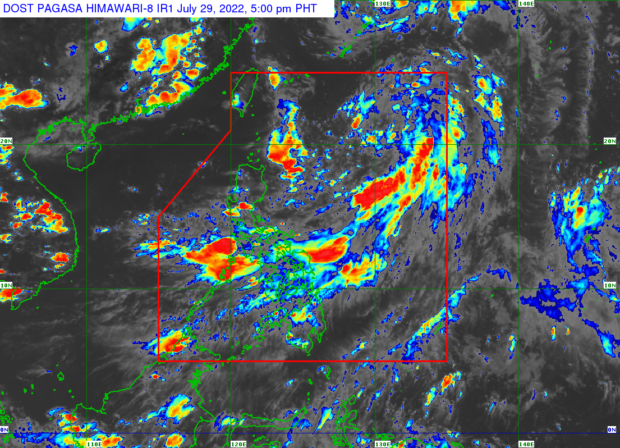Landfall unlikely for TD Ester, but southwest monsoon to intensify – Pagasa

The photo shows the weather satellite image from Pagasa which says on Friday, July 29, 2022, that Tropical Depression Ester may not make landfall but will enhance the southwest monsoon.
MANILA, Philippines — Tropical Depression Ester is not expected to hit land while within the Philippine area of responsibility (PAR) but it is seen to strengthen the southwest monsoon, the state weather bureau said Friday afternoon.
The latest bulletin from the Philippine Atmospheric, Geophysical and Astronomical Services Administration (Pagasa) indicated that light to moderate with heavy rain showers may occur over Southern Luzon, and the western and eastern portions of Visayas in the next 24 hours because of Ester.
Ester was last located 840 kilometers east of extreme northern Luzon, pulling the southwest monsoon, locally termed “habagat,” towards the areas mentioned earlier, according to Pagasa.
Currently, Pagasa said, Ester is packing maximum sustained winds of 45 kilometers per hour (kph) and gustiness of up to 55 kph as it is moving northwestward at a speed of 15 kph.
Pagasa said Ester is not yet expected to intensify and may leave the PAR by Saturday.
Article continues after this advertisementREAD: LPA off northern Luzon develops into Tropical Depression Ester
Article continues after this advertisementSince Ester is not seen to make landfall while in the country, Pagasa said it is not raising any tropical cyclone wind signal. Pagasa said it anticipates the cyclone to hit land or pass near Japan’s Ryukyu Islands, which is northeast of extreme northern Luzon.
No gale warning has been raised as of now, too, but state meteorologists warned that a fortified southwest monsoon might cause moderate to rough seas over the northern and eastern seaboards of the country, with waves reaching heights of 1.3 meters to 2.8 meters.
Still, Pagasa reminded the public to standby for the latest weather updates.
“Considering these developments, the public and disaster risk reduction and management offices concerned are advised to take all necessary measures to protect life and property,” the state weather service said.
“Persons living in areas identified to be highly or very highly susceptible to these hazards are advised to follow evacuation and other instructions from local officials,” it added.